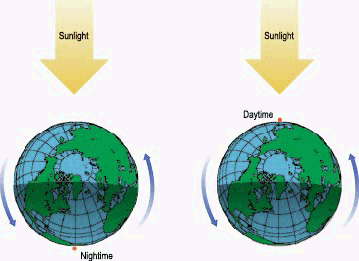Why is there day and night?
![]()
Clearly, when you see the Sun shining in the sky, it is day, and when you don't it is night. So the real question is "why is the Sun in the sky at some times and not at others?" We can see that the Sun seems to move across the sky starting in the east in the morning, moving toward the south at noon, and then toward the west as the day ends. How does this happen?
Long ago, people believed many weird things about the Sun and how it traveled across the sky. The ancient Greeks believed that the Sun rode across the sky in a chariot drawn by four white horses driven by the god Heleius! These days, we know that the Sun appears to move across the sky because the Earth rotates on its axis.
So how does the turning of the Earth lead to the Sun's motion across the sky? It is easy to see this if you shine a bright light on the side of a globe in a darkened room. Find where you live on the globe. Now slowly spin the globe on its axis so that if you look down on the north pole, it is rotating counterclockwise. Watch what happens to the place where you live. Do you see that it is sometimes pointed toward the light (which represents the Sun) and sometimes away from the light? Hey, you've made day and night!
 |
|
When where you are is pointed toward the Sun, it is day. Then the Earth
rotates you away from the Sun, and it is night.
|
So, how fast does the Earth have to rotate in order to make one complete spin in 24 hours? At the equator, the Earth is rotating at a speed of about about 2200 kilometers per hour. Good thing we human beings can't feel this motion!
![]()
The StarChild site is a service of the High Energy Astrophysics Science Archive Research Center (HEASARC), within the Astrophysics Science Division (ASD) at NASA/ GSFC.
StarChild Authors: The StarChild Team
StarChild Graphics & Music: Acknowledgments
StarChild Project Leader: Dr. Laura A.
Whitlock
Curator:
Responsible NASA Official: